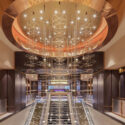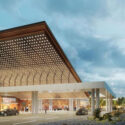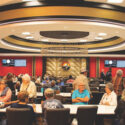
Today’s casino experience—post Covid reopenings—is nothing like it was intended to be. The excitement of a slot jackpot can now only be celebrated from six feet away. Table game players are often separated from other players and the dealer by a Plexiglas shield. And in many jurisdictions, takeout from casino restaurants to your room is the best choice. And always masks are mandatory.
What does this mean for the future of casinos? Their business models aren’t built for today’s realities. With no entertainment, no meetings or conventions, no special events, and an underperforming gaming floor as a result of these restrictions, how will casinos survive? And with demographics changing, how can casinos meet the expectations of their younger clientele?
Casino architects and designers believe there is a way out. While these current constraints are onerous, shows and conventions and full-service F&B will eventually return. But what will be the experience, and how will casino executives decide how to best serve their best customers?
Gaming Floor Redux
Even before Covid, the casino floor was changing. Increased competition and interactive alternatives made the casino floor less congested, more flexible and slowly evolving.
Brett Ewing, a principal with the Cuningham Group, says the extra space will allow for more comfort for players.
“One of our clients had some extra back-of-the-house space,” he says. “They took down the walls, laid down some carpet and spread their machines out. Short rows, small carousels, no Plexiglas. Customers really appreciated the fact that they spread it out, and they lost very few games.
“The key is flexibility. Our clients are going to want to pivot as they see new trends evolve and it becomes more clear about what their customers are looking for. There are important densities to consider when you’re talking about the relationship of table games to slot machines. We need to figure out where the critical mass is for the energy of the casino to be fully involved.”
Mike Larson, an architect and project director for JCJ, predicts the slot floor will change markedly.
“We’ll see a regrouping of the way slots are laid out,” he says. “We’ll largely eliminate side-by-side slot machines. It will also free up space for other uses. The real opportunity is how to use the extra space in a flexible nature to give your guests a way to enjoy themselves that may not be traditional for a casino floor.
“Fewer players at tables could become the norm or at least an option. There are people who enjoy the extra space. But how do you create energy on the floor with fewer players? We’ve been talking about how you could change the actual tables. What innovations could be introduced that could integrate technology that would make it easier to play and prevent the spread of germs?”
Tom Sykes, a principal with SOSH Architects, believes there needs to be more radical changes on the casino floor.
“There needs to be a great emphasis on familiarization and comfort with remote gaming, and gaming in whatever place you’re located in the casino,” he says. “There needs to be an interface that will kick in that will link interactive and in person gambling or even gambling from your home.”

Every other slot machine is turned off at most casinos due to Covid 19
Nick Schoenfeldt, a principal with TBE Architects, believes the space on the casino floor could be repurposed, and explains how they did it with one client.
“We’re utilizing space more efficiently,” he explains. “We abandoned poker in favor of a non-smoking slot area. We’re spreading out the machines more so people can safely social distance.
“Even before Covid, I think the relaxed atmosphere was moving forward. People didn’t like being right on top of one another like a cattle call. They like being spread out. So even after Covid passes, people are going to want to continue that more relaxed, more space.”
Sykes says that the days of an ocean of slot machines are over.
“Right now, we’re developing different zones to allow more engagement on the casino floor,” he says. “We’re no longer locked to the rows of slots. We’re pulling out a few machines in exchange for more space. We need to change how the environment feels.”
Sykes’ partner at SOSH, Bill Salerno, says the capacity restraints didn’t really have an impact.
“You don’t know what to expect when the limits were imposed,” he says. “The casinos are very happy with 25 percent, which they never hit. Expenses are down because of less staff, marginal F&B. So they’re making some money and doing OK even with these limitations.”
Paul Steelman, founder and president of Steelman Partners, believes some basic changes need to be made across the spectrum.
“We want to reduce the touchpoints,” he says. “We want to reduce chips, we want to reduce cash, we want to reduce the cash machines. We want to take advantage of the technologies that exist today on our phones, to integrate the phone much more so into the casino design, whether it be a slot machine, or whether it be a gaming table. In the hotels, we’re doing things like making the phone be your remote control in your hotel room; the phone can open up your hotel room as a key. Therefore, we can make our lobbies smaller, because people are going to be checking in on their phone, as 5G proliferates throughout the entire world.”
Food & Beverage Changes
The buffet is dead. Almost all architects agree. But how will we replace the buffet?
“The original buffet concept has changed,” says Schoenfeldt. “We’re adding additional screens and wider seating layouts, and we’re using technology so guests can order from their tables. Of course, they can order as much as they want just like a buffet, but they won’t be touching or even seeing the food until it gets to their table.”
Ewing believes the food court concept will come back, but with major changes.
“We all know what the old food courts look like,” he says. “We’ve already been trending away from that for some time now. It’s already a much more engaged experience. That’s already taking us in another direction from the traditional food court. I think we’re going to see an incorporation of grab-and-go. Not just a premade sandwich, but a meal made to order using high-quality ingredients. One of the most unpleasant experiences with food courts was trying to find a table. The experience of dining in your room is going to evolve very quickly.”
Sykes believes that there will be some sea changes in the food-and-beverage approaches from the casinos.
“It’s back to the future,” he says. “I think there’s going to be a trend toward third-party food and beverage. Buffets have always been house-owned, but they’re not going to exist anymore. There will be food halls and eateries and entertainment that makes it fun to eat and try different things. It can be very formal or very informal. We’ve already seen a pattern of outsourcing to third-party food vendors. You know how to run a casino, but restaurants and buffets are marginal. Let someone do it who’s an expert at it and has a name.”
Going forward, Ewing says the capacity limits are more problematic for restaurants.
“If you operate at 50 percent capacity, restaurants can’t survive, even in a casino environment,” he says. “So new restaurants have to be designed with that in mind and right-size the capacity. Restaurants are going to have to offer take-away service and maybe even incorporate some level of customer service into the guest rooms.
“Where you would once have had a long row of booths, the design will be more flexible. There might be a big family booth in the corner, but there will have to be flexibility until we see what will happen with social distancing. If you do have booths that are back to back, you’ll have a screen that physically separates the customers. It would be something very artful and decorative so it could be a permanent change.”
Steelman says the trend will now be for restaurants to offer outdoor space as well on patios or other enclosed spaces.
“Over time, we have started to see a lot more integration of outdoor spaces,” he says. “Now, they weren’t necessarily integrated in accordance with the virus that we currently have, but they have proved useful. We think that the restaurants will be fine, but I’d be surprised in the future if we do a lot of indoor restaurants.”
Entertainment Options
Showrooms and large concert halls have yet to come back, but the smaller shows have returned, particularly in Las Vegas where both MGM Resorts and Caesars Entertainment have opened several shows at their Strip properties. Social distancing and mask wearing are required, but it’s heartening to see entertainment return.
Schoenfeldt says that some of his tribal clients are eschewing larger national entertainment.
“There’s going to be a building trend toward smaller venues where local talent can be showcased,” he says. “These days you don’t need the huge superstars to pack a big ballroom, since you can’t pack it anymore, or at least for quite a while.”
Sykes says while the larger showrooms can be apportioned off in order to honor social distancing, that won’t help casinos sign the bigger acts that demand higher fees.
“I don’t think you’ll see the headliner or the more expensive talent for some time,” he explains. “Casinos will be looking for the more affordable, B-level acts, because the seating is going to be more dispersed and you won’t be able to pack a theater.”
As for the nightclubs that have become so important to the bottom line, there is no light at the end of the tunnel, according to Ewing.
“Nightclubs are tough,” he says. “There’s no way around the social distancing at nightclubs. But one thing I know after having a fair amount of experience designing them is that nightclub operators are smart. If there’s a way to do it, they’ll figure it out. It’s already happening. At Marquee at the Cosmopolitan, they’ve already repurposed their outdoor area as a nighttime poolside environment. It might not be a long-term solution but it proves the desire is there. We’re going to have to really look hard at what the appetites of millennials and Gen Z are toward social proclivities going forward.”
Salerno agrees that the desires of the younger generation will drive innovation.
“Prior to Covid there was already a changing of the guard occurring,” he says. “Baby boomers and blue hairs were getting older. Casino operators were concentrating on how we replace them with younger gamblers. The Covid situation has accelerated that. They need to figure out what they want and how they want it.”
Changing Times
Most designers believe that technology will play a role in anything they imagine going forward.
Larson says the mobile devices are front and center.
“The biggest change is going to be the use of apps,” he says. “A lot of these properties have been looking into this for some time, but now it’s going to be accelerated. This situation is supercharging that rollout. We’re seeing apps that help you check in and make dinner reservations. These apps can track your location so maybe they can help increase mobile betting or allow players to place wagers while they’re at dinner. If we have a seating area or lounge or sportsbook in the middle of the casino, people could actually be gaming there on their devices. This is something that’s going to be rolled out very quickly.”
Health and safety are also going to depend largely on technology. Sykes says many of his clients are already installing equipment that ionizes the air and therefore kills any virus—including Covid—in the air entering the casino resort.
“It’s a very achievable goal and quick to implement,” he says.
Steelman believes a casino resort could be the safest place to be with regards to air handling.
“I believe that good engineering, good operations, will all be put together in this particular place, in this particular building, to probably create the safest, cleanest casino in the world,” he says.
“Casinos do in fact change the air more than any other building. The casinos, especially in Las Vegas with some of the finest engineers, are probably the freshest, cleanest air in any building, other than a hospital operating room.”
Along with technology, says Schoenfeldt, it’s going to take human aspirations to solve these problems.
“Change is something we always embrace at TBE,” he says. “It’s exciting when you see the creativity of the people and what they come up with. And 90 percent of it is creative perception. They know how clean it is. They understand how much attention the staff is paying to cleanliness. I don’t think the average gambler is going to be comfortable exactly as it used to be—ever. If we’re given the opportunity to do something we love and enjoy and if we can do it safely, we’re going to make those changes and some of them are going to be here to stay.”

















